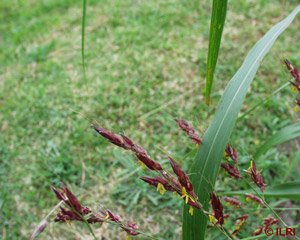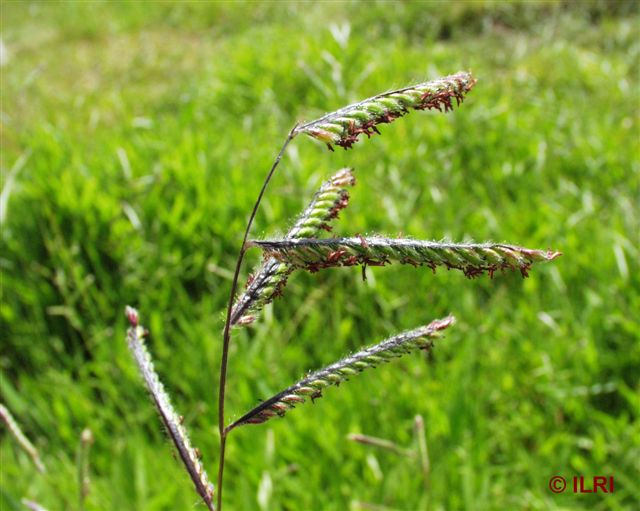Characterization of forage grass genetic resources
Contributors to this page: ILRI, Addis Ababa, Ethiopia (Jean Hanson); Bioversity International/ILRI, Addis Ababa, Ethiopia (Alexandra Jorge).
|
Contents: |
Planting and cultural practices for characterization
Environment
- The environment should be selected on species adaptation. Click on the tropical grasses table for species specific information (the environment should be suited to the species for the traits to be expressed for characterization).
Soil type
- Soil type should be selected on species adaptation. Click on the tropical grasses table for species specific information (the soil type should be suited to the species for good growth).
Rainfall
- Rainfall of 500 mm with irrigation or 1000 mm rainfed for most forage species.
- Irrigate the field directly after sowing or planting of root splits if first rain is delayed.
- Supplementary irrigation should be applied as necessary to ensure adequate seed yield to measure seed traits (sufficient rainfall or supplementary irrigation is essential for flowering and seed set to observe floral traits).
Season
- Data should be usually taken at 50% flowering for forages. This may be end of the wet season for annuals and anytime that flowering occurs for perennials (morphological data is best taken at plant maturity when 50% of the plants are flowering, when most traits are fully expressed).
Plot size
- Either plots of 2 m2 or 25 m2 or single rows of at least 2 m long per accession depending on species (plot size should be large enough to accommodate at least 10 plants for data collection).
Sampling area/border area
- Quadrates of 50 cm to 1 m for yield and ten plants from within the centre of the plot for morphological traits (this has been shown to be statistically acceptable for forage crops).
Plant density
- Plant density varies with size of plants. Click on the tropical grasses table for species specific information (this has been shown to be statistically acceptable for forage crops).
Replications
- Phenotypic traits should be measured on ten plants selected at random from each accession (this has been shown to be statistically acceptable for forage crops by van de Wouw et al, 1999). Biomass should be measured on plant samples for nutritional analysis taken from a minimum of three replications and preferably four. If replicates are used, phenotypic traits can be measured on ten plants across replications.
Standard check cultivars
- None used since there are few cultivars for many forages.
Frequency of standard checks
- Not applicable.
Time of day for data collection
- Time of day should be selected for each species when flowers are open.
|
|
Morphological descriptors for characterization
- See list of forage grass descriptors developed by IBPGR (now Bioversity International) CEC Secretariat, Brussels (1985).
- Specific descriptors are also available for:
Pictures for characterization
Sufficient detail should be captured in images to taxonomically identify the plant and demonstrate the traits that show variation.
- Take images for character(s) which may be difficult to describe verbally.
- Images of whole plant, flower spikes, seeds.
- Store in a database file linked to other characterization data.
 |
|
|
Brachiaria dictyoneura florets (photo: ILRI) |
|
Herbarium samples for characterization
Sufficient detail should be captured to taxonomically identify the plant and demonstrate the traits that show variation.
- Take and store vouchers for future reference and taxonomic verification.
- Collect plants with leaves, flower spikes and seeds as well as roots. Roots are very important for grasses.
- Spread plants open before pressing, and arrange leaves and flowers to show both sides.
Molecular descriptors for characterization
- SSR, EST-SSR, AFLP, RAPD (these are more efficient techniques).
Nutritional traits for characterization
The main use for forages is for livestock feed. Nutritional traits are therefore very important. Some common ones include:
- Crude protein.
- Minerals (P, K, Ca).
- Palatability.
- Digestibility.
- Fibre (neutral detergent fiber, Acid detergent fiber).
- Lignin.
 |
 |
|
|
Sorghum almum flower with anthers (photo: ILRI) |
Sorghum almum inflorescence (photo: ILRI) |
|
 |
||
|
Brachiaria ruziziensis inflorescence (photo:ILRI) |
Recording information during characterization
The following information must be recorded for each trial:
- Site (name of site with coordinates if possible).
- Planting date (date of sowing/planting).
- Harvesting date (date when plot was harvested - for nutritional/yield traits).
- Data collection date (date when data was collected).
- Data collector (full name).
- Trial identifier (reference number for trial).
References and further reading
IBPGR, CEC. 1985. Forage Grass Descriptors. International Board for Plant Genetic Resources Secretariat, Rome, Italy; Commission of European Communities Secretariat, Brussels. Available from: www2.bioversityinternational.org/publications/Web_version/420/. Date accessed: 16 Jan 2011.
Van de Wouw M, Hanson J, Nokoe S. 1999. Observation strategies for morphological characterisation of forages. Genetic Resources and Crop Evolution 46:63-71.
Click here for a list of selected references on characterization of forage grass genetic resources.
Comments
- No comments found





Leave your comments
Post comment as a guest